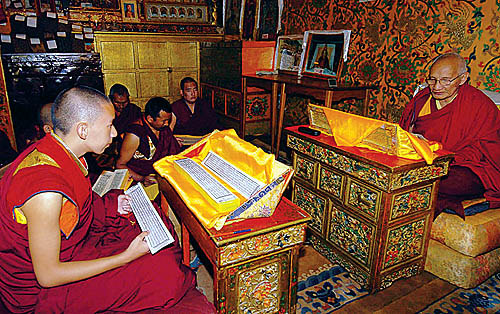|

In the early 7th century, Buddhism made its way into Tubo (the old name of Tibet) from Nepal and China's Central Plains (the middle and lower reaches of the Yellow River). Songtsan Gambo, the Tubo king, married Princess Wencheng of the Tang Dynasty (618-907) and the Nepalese Princess Bhributi. Each princess brought to Tubo a statue of Buddha, and their accompanying artisans built the Jokhang and Ramoche monasteries in Lhasa to house them. Their accompanying Buddhist monks then set about translating Buddhist scriptures.
Buddhism first became popular among the nobility and then gradually spread among the common people in the 7th century, but it collided with the Bon religion then holding sway. For hundreds of years, Buddhism absorbed many contents of the Bon religion and the folk religion. Gradually, strongly influenced by cultures of the surrounding areas, Buddhism in Tibet grew to possess voluminous classics, rich scriptural tenets, a sound monastic system, a strict sutra study system and meditation system; later, the Living Buddha reincarnation system emerged. Finally, it became a special branch different from the Han Buddhism and Pali-language Buddhism-Tibetan-language Buddhism also known as Lamaism.
Through long-time evolution, Tibetan Buddhism was split into many sects, mainly Nyingma (known as the Red Sect), Sagya (known as Colorful Sect), Gagyu (known as the White Sect) and Gelug (known as the Yellow Sect). Of all the sects, Gelug, founded by Zongkapa after his religious reform in the early 15th century, was the most powerful. The two major Living Buddha systems, Dalai and Panchen, came from the Gelug Sect.
Through a prolonged period of cultural exchanges, Tibetan Buddhism is practiced mainly in China's Tibet as well as Qinghai, Gansu, Sichuan and Yunnan Provinces, plus areas concentrated with such ethnic groups in China as the Mongolian, Tu, Yugur, Lhoba, Moinba, Naxi, Pumi and Han. It has worshippers also in Bhutan, Nepal, Mongolia and Russia.
During the heyday of Tibetan Buddhism, each Tibetan family was required to provide at least one member to become a monk or nun. This is why Tibetan monks and nuns made up 25 percent of the Tibetan population in the 16th century and thereafter. In 1951 when Tibet was peacefully liberated, there were 100,000 monks and nuns, or over 10 percent of the Tibetan population in Tibet. After the Democratic Reform in 1959, all monasteries went through reform according to suggestions by the 10th Panchen Erdeni. Tibetan people have since enjoyed freedom to be lamas or resume secular life. |
